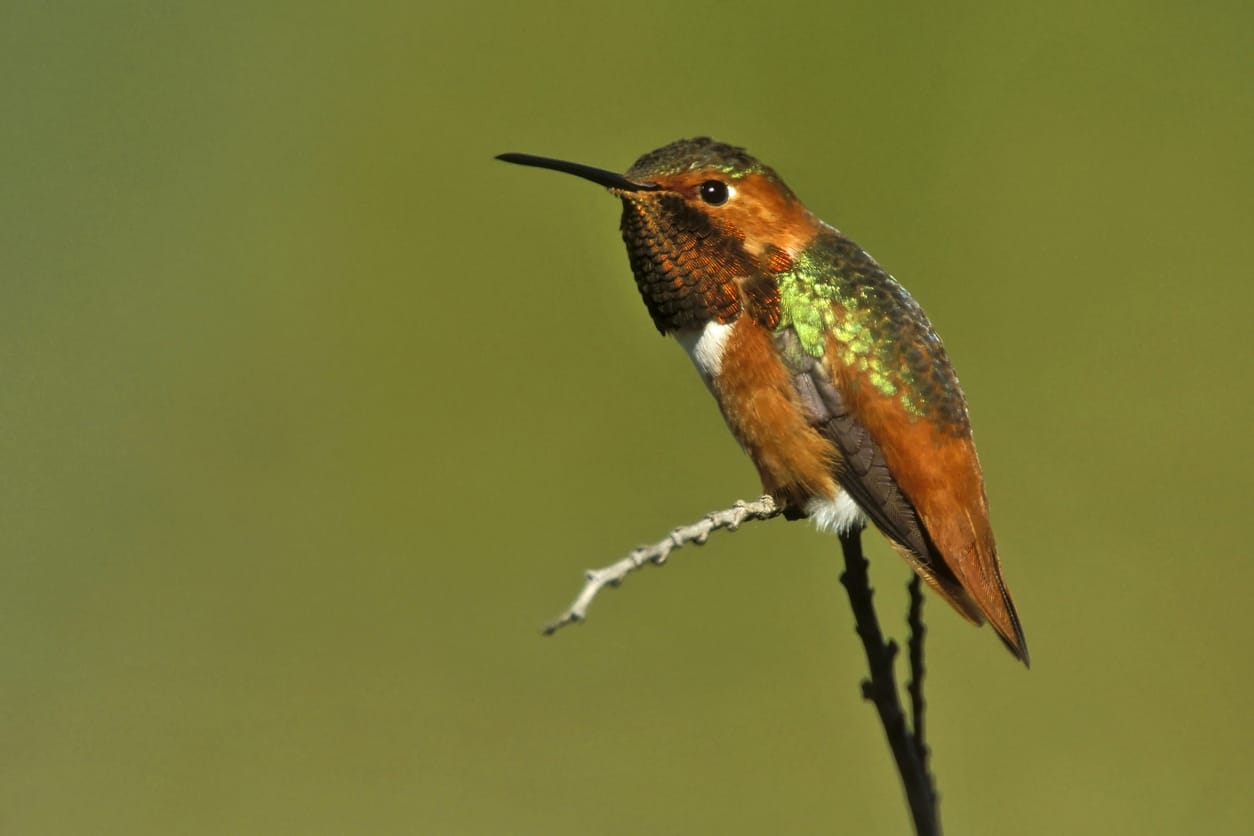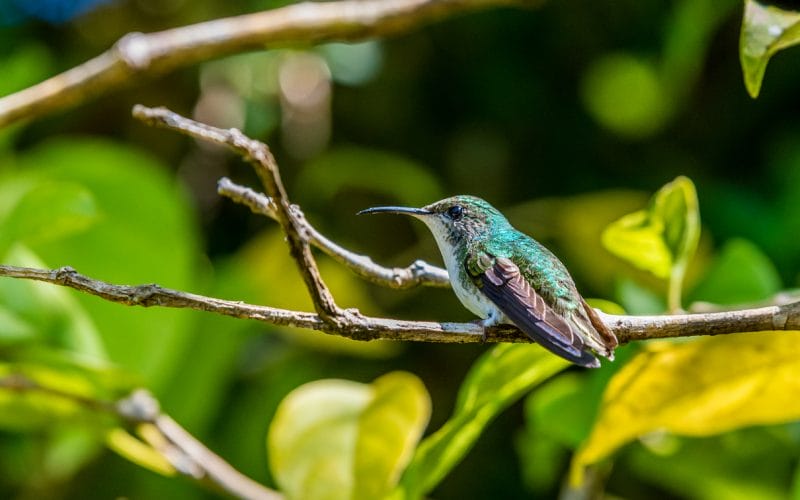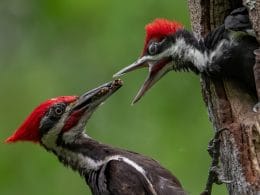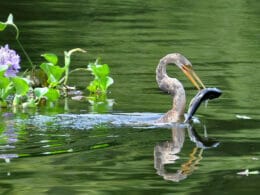There’s no denying that Massachusetts is blessed with great weather and forest lands. Thankfully, this made it an attractive location for a plethora of birds migrating through the region.
As we finally move out of winter, there is an impressive range of beautiful birds to keep an eye out for in Massachusetts, such as the Blue Jay and the Northern Cardinal.
But it’s usually the ever-charming hummingbirds that steal the show. You don’t need to go far to catch a glimpse of these gorgeous creatures, as most of them can be admired from as close as your backyard.
In case you don’t exactly know what you’re looking for/at, we got you covered.
We brought you everything you need to know about all the hummingbirds in Massachusetts, from the common all the way to the super rare.
6 Must-See Hummingbirds in Massachusetts
1. Ruby-throated Hummingbird
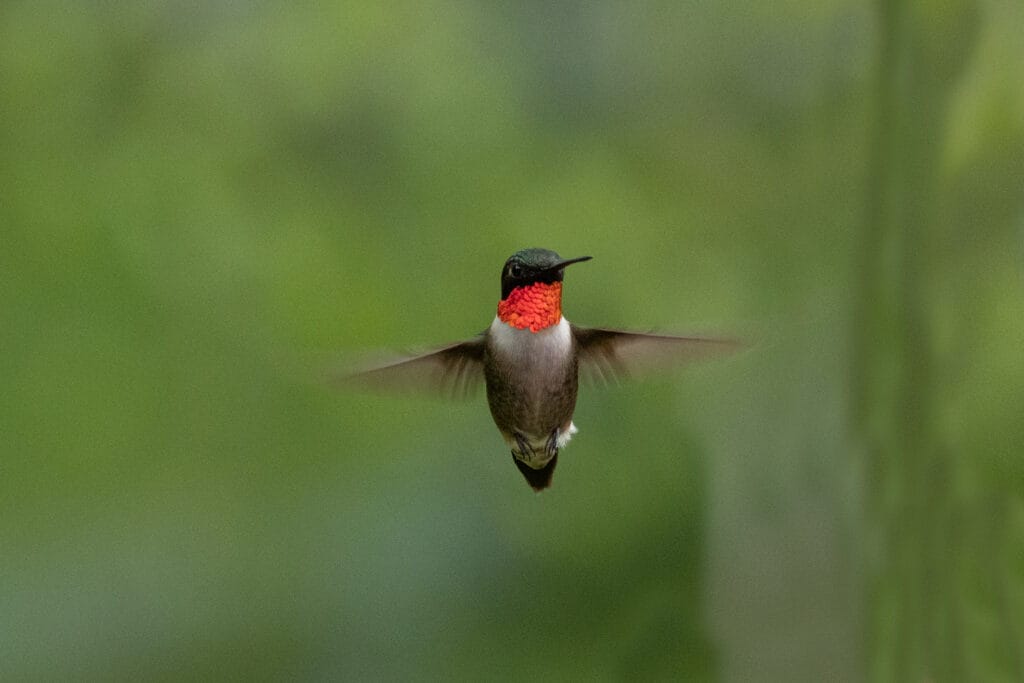
- Scientific name: Archilochus colubris
- Length: 2.8 to 3.5 inches (7 to 9 cm)
- Weight: 0.071 to 0.212 oz (2 to 6 g)
- Wingspan: 3.1 to 4.3 inches (8 to 11 cm)
- The bird’s commonality in the region: Common
Considered to be the most common hummingbird in Massachusetts, the Ruby-throated Hummingbird is the only variant of the bird that nests and breeds in Massachusetts.
This magnificent creature, which appears in both forested areas and backyards alike, got its name from its red-colored feathers covering its throat.
Appearing as if it’s adorned with jewels on its neck, they are a sight to behold, especially when the light shines on their distinct features.
Author Note: Flapping/beating their wings approximately 53 times per second, these little guys/girls can zip in all directions and fast too.
They’re attracted to tube-shaped nectar-filled flowers and hummingbird feeders making them usual backyard guests during mid-spring and the summer months.
Even though the Ruby-throated Hummingbird is small in size, this species is considered to have the largest breeding range of any North American of its kind, and they nest everywhere.
They’re not particularly scared of humans that much and have accustomed themselves to the world around them. So it’s not unusual to see their nests near man-made structures.
Their small nests can be found almost anywhere including on loops of chain, on roofs, in forests, and more.
2. Rufous Hummingbird
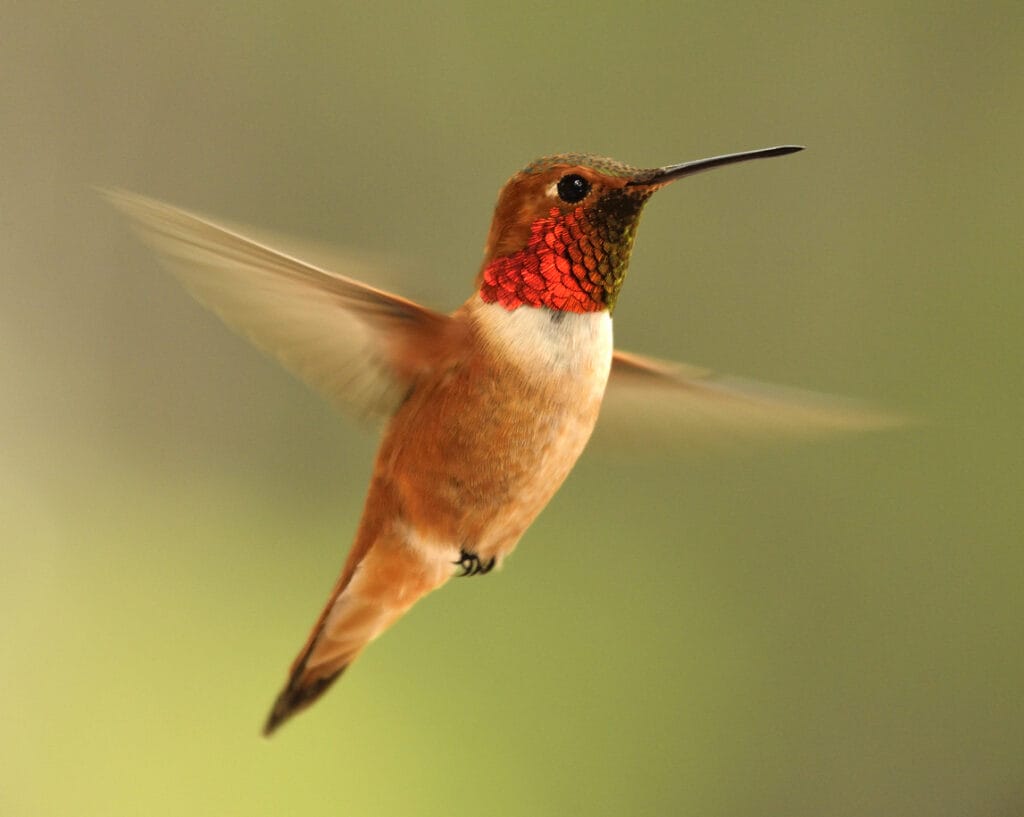
- Scientific Name: Selasphorus rufus
- Length: 2.8 to 3.5 inches (7 to 9 cm)
- Weight: 0.1 to 0.2 oz (2 to 5 g)
- Wingspan: 4.3 inches (11 cm)
- The bird’s commonality in the region: Less common
While the Rufous Hummingbirds don’t breed on the east coast, they have the second most sightings in Massachusetts after their Red-throated cousins.
These little feisty critters are brazen and bold when it comes to their attitude toward other hummingbirds.
It’s not unusual to see some of them chasing away other hummingbirds from feeders, even if they were bigger in size.
The copper-orange coat of the males matches their fieriness. They even have glittery throats that resemble fire in the right light conditions.
The females, on the other hand, have more of a green shade accompanied by rusty-ish patches, making them quite distinguishable from the males.
The Rufous Hummingbird’s sightings, unfortunately, aren’t that widespread over all of Massachusetts, with most of the sightings restricted to the east of the state.
3. Black-chinned Hummingbird
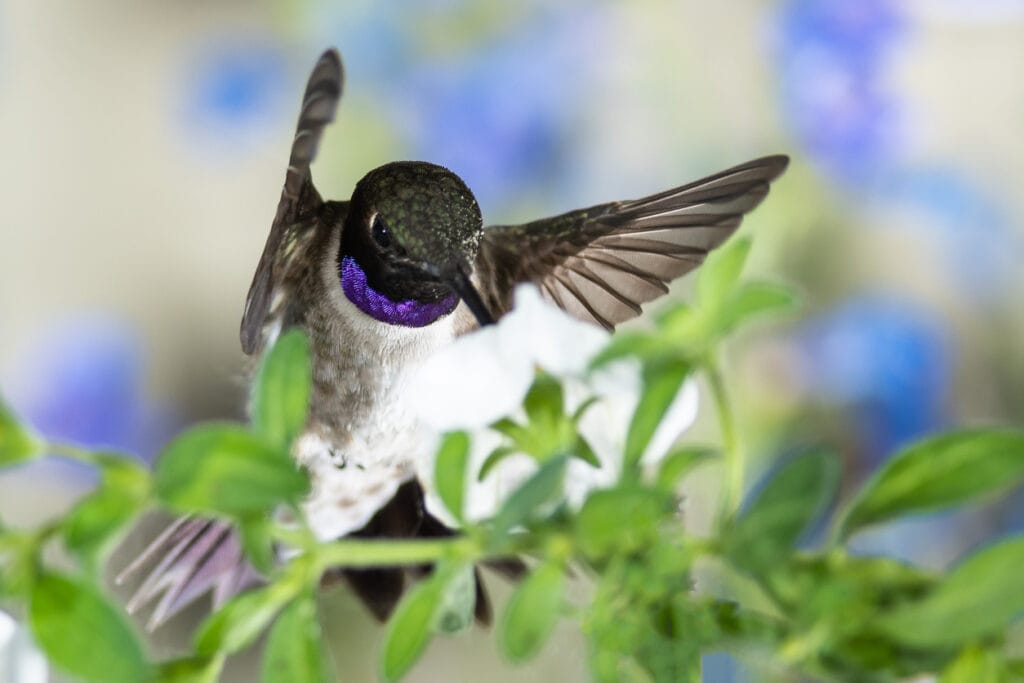
- Scientific name: Archilochus alexandri
- Length: 3.25 inches (8.25 cm)
- Weight: 0.1 to 0.2 oz (2.3 to 4.9 g)
- Wingspan: 4.3 inches (11 cm)
- The bird’s commonality in the region: Rare
These are very rare to see in the area, however, there have been a few sightings in the past few years, making seeing one of these small birds a unique treat.
The Black-chinned Hummingbird is a beautiful creature, especially the males with their distinct iridescent purple throat.
Top Tip: Both the males and females share the same metallic green feathers that turn greyish white near their bellies.
The males are a little bit different as they have their extra purple flair, while the females have a plain throat.
Unlike other species, the Black-chinned Hummingbirds aren’t attracted as much to the color red, flowers, or feeders.
4. Allen’s Hummingbird

- Scientific Name: Selasphorus sasin
- Length: 3 to 3.5 inches (76 to 89 mm)
- Weight: 0.1 oz (2 to 3 g)
- Wingspan: 4.3 inches (11 cm)
- The bird’s commonality in the region: Very rare
Spotted only a handful of times throughout the past few years in Massachusetts, Allen’s Hummingbirds can be easily mistaken for the Rufous hummingbirds due to their similar colors.
The tiny males have a shade of orange throughout, along with a dull-green back which differentiates them from the Rufous birds that have a coppery-brown back.
On the other hand, the males also sport a bright-orange throat similar to their Rufous counterparts, yet, with a slightly deeper tone.
Top Tip: The females have a bronze body and a paler but speckled throat compared to the males.
Unlike most birds, this species tends to take the phrase “the early bird catches the worm” to heart, as it’s one of the very fewest birds that depart for breeding grounds in the middle of winter.
5. Calliope Hummingbird

- Scientific name: Selasphorus calliope
- Length: 2.8 to 3.9 inches (7 to 10 cm)
- Weight: 0.071 to 0.106 oz (2 to 3 g)
- Wingspan: 4.3 inches (11 cm)
- The bird’s commonality in the region: Extremely rare
The smallest bird in the USA! The very rare Calliope Hummingbirds breed in the northwest and Canada. That being said, there have been a few stragglers seen in Massachusetts dating as far back as 2002.
Like the rest of the hummingbirds on the list, the males are the ones with most of the panache. They tend to have a unique magenta pattern on their throat forking down on the sides.
Both eccentric and easy to pick out, the rest of its body, both the males and females have a greenish hue on their feathers.
On the other hand, the females feature a peachy belly with some green specks near their throats.
Not only beautiful, but they also share the same feistiness found in the Rufous hummingbird!
During the breeding seasons, they get very territorial; going as far as chasing hawks away in some areas on the west coast.
6. Broad-billed Hummingbird
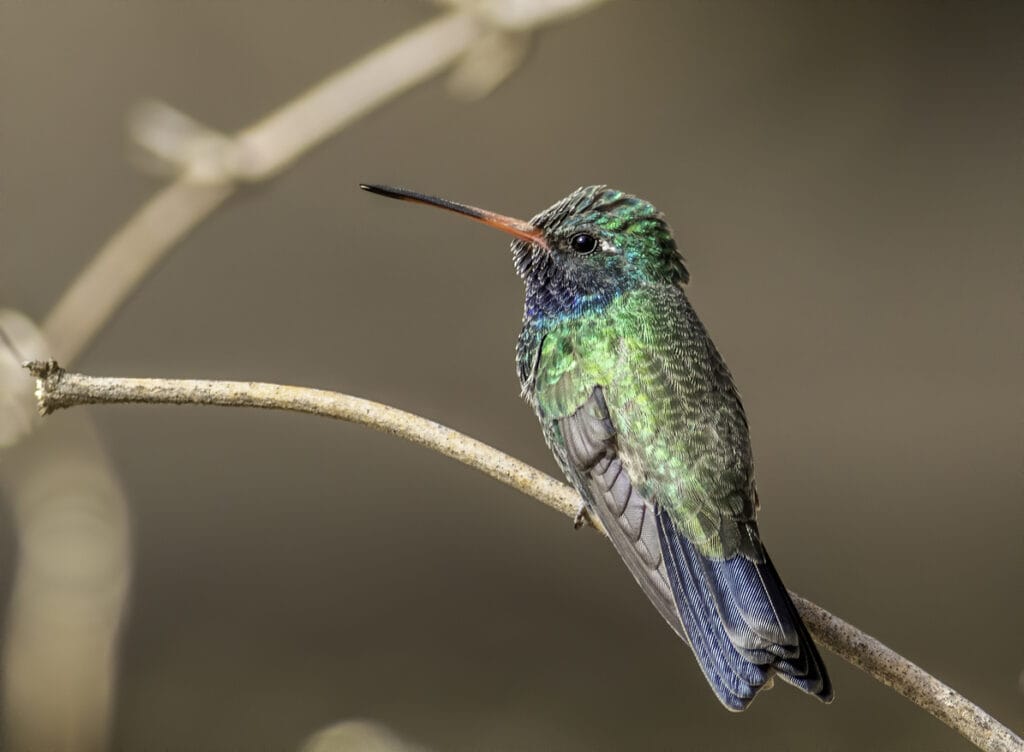
- Scientific name: Cynanthus latirostris
- Length: 3.1 to 3.9 inches (8 to 10 cm)
- Weight: 0.1 to 0.2 oz (3 to 4 g)
- Wingspan: 5.1 inches (13 cm)
- The bird’s commonality in the region: Almost never
If you live in Massachusetts, there is a high probability that you’ll never see this kind of hummingbird in your state, however, there has been a recorded sighting dating back to 2008.
Unfortunately, any sighting of the Broad-billed Hummingbird in Massachusetts is going to be one that lost its way. So if you see one, you’re one of the lucky few!
Author Note: The Broad-billed Hummingbirds are very unique; the males have a shiny blue-green tint all over their body, with a black-tipped red bill.
Taking eyeliner to a whole new level, the females have white streaks over each eye, while their bodies have a golden-green shade, and their bellies are light grey.
When Do Hummingbirds Travel To Massachusetts?
As we mentioned earlier, the Ruby-throated hummingbird is the only one that nests and breeds in the area. They tend to migrate through the area mid-spring.
Expect the little birdies mid to late April as spring goes in full bloom, so that’s when you’re going to want to start attracting them to your backyard.
What Do I Do to Attract Hummingbirds to My Backyard?
These tiny flyers are colorful, beautiful, and friendly, so it’s easy to understand why people love seeing them, and why they want to attract them to their backyards.
We handpicked some methods to help make peoples’ backyards become more attractive for migrating and breeding hummingbirds, so people and hobbyists alike can appreciate their beauty up close.
Flower Power!
These magnificent creatures have impressive color vision and are attracted to bright colorful flowers; so why not add some of your own?
Orange and red-hued flowers are usually your best bet because they stand out for hummingbirds like a neon sign; telling them a buffet is available here.
Ruby-throated hummingbirds in particular love tube-shaped nectar-filled flowers, especially the aforementioned red ones, so Red Daylilies and Cardinal Flowers can be a good choice.
Tiresome
The problem that arises from this method is that it has to be maintained to stay pretty and healthy.
This means that you’ll have to keep that green thumb of yours active, and be up to date with its upkeep, which some people consider a hobby while others a curse.
Plants/flowers can also attract other insects into your life, such as bees and wasps, so be on the lookout if you have allergies.
A Cool Dip In The Hot Weather
Hummingbirds, like other birds in the wild, love taking a dip in the water especially if it’s hot outside.
An addition of a small birdbath in your backyard is not a bad idea, because not only will they enjoy drinking the water, but they can bathe in it too, cooling off during the summer afternoons.
The size and shape of the birdbath will be up to you to decide. There is a wide variety of shapes and sizes with varying prices on the market, so choose the one that works best for you.
Warning
Be careful though, because a birdbath might invite all kinds of creatures not only hummingbirds.
Hawks, squirrels, possums, and other thirsty creatures can use the opportunity that there’s clean water in your backyard for them to drink, so keep that in mind when getting one.
The Man-Made Method
While red flowers are great for attracting hummingbirds, man-made alternatives such as feeders are another good solution.
The feeder is essentially filled with a nectar solution that you make and is put in your backyard or garden.
It attracts hummingbirds with its color and nectar’s scent, so that they could come close and feed through the small flower-shaped holes at the bottom.
They don’t need to replace your garden and plants completely, but rather act as an alternative for the tiny birds to enjoy the nectar from.
Hummingbird feeders come in all kinds of different shapes and sizes. There are also different ones based on materials like glass and plastic, so the options are endless.
Each of them has its benefits and issues so pick the feeder that suits you best. For example, the glass one is a safe bet, but it’s prone to breaking, unlike the plastic one.
Unfortunately, the plastic version could leave toxic residues so research is a must before purchase.
Making the nectar solution inside the feeder is simple:
- Mix four parts of water with one part sugar in a pot and bring to a simmer.
- Once the sugar completely dissolves in the water, remove the pot from the heat.
- Wait for the whole thing to cool to room temperature.
- Do NOT add any red dye to the solution.
- Fill the feeder.
- Wipe away any excess.
- Hang the feeder in the desired location.
Issues That Might Arise When Using A Feeder
Unfortunately, feeders attract other creatures too!
1. Bees
Bees are a concern because they’re attracted by the nectar too, so here are some solutions if you decide to continue with this option:
- Buying a feeder with a bee-guard.
- Getting feeders that don’t have the color yellow on them as it attracts bees.
- Changing the location of the feeder from time to time.
- Wiping away any excess nectar on the outside of the feeder before rehanging.
2. Ants
Ants like nectar too, but they have to climb their way to the feeder. Don’t skip on buying an ant-moat.
This “moat” or “guard” creates a water barrier the ants can’t cross and thus keeps the nectar clean and safe for the hummingbirds to enjoy.
3. Cats
Stray cats are hungry, and small birds on a feeder are easy prey, so moving the whole thing to a place where the felines can’t pounce is a great idea to keep them protected.
4. Upkeep
The nectar ferments and turns into toxic alcohol over time, which is bad for hummingbirds. As a precaution, changing the nectar before it turns cloudy, or once a week should do the trick.
Final Words
Hummingbirds are magnificent creatures and are truly worth the effort of attracting them. Imitating miniature helicopters around flowers, they’re definitely one of nature’s most fascinating tiny wonders.
Now that you’re armed with the knowledge you need, set out and look for them! That’s if you want to check them out from the comfort of your own backyard.
The Parker River National Wildlife Refuge, Daniel Webster Wildlife Sanctuary, and the Wellfleet Bay Wildlife Sanctuary are all great places to start your birding adventure.
Just remember that while there are many methods of inviting them over to your backyard, you might be attracting other creatures too. We hope you enjoyed our write up on common hummingbirds in Massachusetts.
FAQ
To find out where recent sightings of hummingbirds have been, try eBird. You can search for the latest sightings or particular species or what has been seen in a certain area.
The most common hummingbirds in Massachusetts are the Ruby-throated and Rufous Hummingbirds.
We have listed some great all round birding spots in Massachusetts above but for hummingbirds, try hanging a feeder in your backyard. It’s a great place to start.




